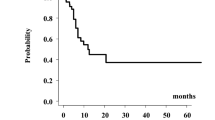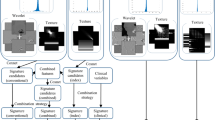Summary
A study was made of the relationship between measurements of radiosensitivity versus proliferation and p53 status in head and neck cancers. Inherent tumour radiosensitivity was assessed as surviving fraction at 2 Gy (SF2) using a clonogenic soft agar assay (n = 77). The results were compared to data on proliferation obtained by both flow cytometry (labelling index (LI), the potential doubling time (Tpot) n = 55) and immunohistochemistry (Ki-67 and PCNA; n = 68), together with immunohistochemical p53 expression (n = 68). There were no overall significant differences in the median values of the various parameters analysed for the different sites within the head and neck region, disease stages, grades of tumour differentiation or nodal states. A subgroup analysis showed that oropharyngeal (n = 22) versus oral cavity (n = 35) tumours were more radiosensitive (P = 0.056) and had a higher Ki-67 index (P = 0.001). Node-positive tumours had higher LI (P = 0.021) and a trend towards lower Tpot (P = 0.067) values than node-negative ones. No correlations were seen between SF2 and any of the parameters studied. The long-standing dogma of an increased radiosensitivity of rapidly proliferating cells in contrast to slowly proliferating cells was not confirmed. The study shows that parallel measurements of different biological markers can be obtained for a large number of patients with head and neck cancers. The independence of the various parameters studied suggests that there may be potential for their combined use as prognostic factors for the outcome of radiotherapy.
Similar content being viewed by others
Article PDF
Change history
16 November 2011
This paper was modified 12 months after initial publication to switch to Creative Commons licence terms, as noted at publication
References
Begg, A. C. (1995). The clinical status of Tpot as a predictor? or why no tempest in the Tpot!. Int J Radiat Oncol Biol Phys 32: 1539–1541.
Begg, A. C. (1997). Individualization of radiotherapy. In Basic Clinical Radiobiology, Steel GG Arnold: London 234–245.
Björk-Eriksson, T., West, C. M. L., Karlsson, E., Slevin, N. J., James, R. D. & Mercke, C. (1998). The in vitro radiosensitivity of human head and neck cancers. Br J Cancer 77: 2371–2375.
Bourhis, J., Wilson, G., Wibault, P., Bosq, J., Chavaudra, N., Janot, F., Luboinski, B., Eschwege, F. & Malaise, E. P. (1993). In vivo measurement of the potential doubling time by flow cytometry in oropharyngeal cancer treated by conventional radiotherapy. Int J Radiat Oncol Biol Phys 26: 793–799.
Bourhis, J., Bosq, J., Wilson, G. D., Bressac, B., Talbot, M., Leridant, A. M., Dendale, R., Janin, N., Armand, J. P. & Luboinski, B. (1994). Correlation between p53 gene expression and tumour-cell proliferation in oropharyngeal cancer. Int J Cancer 15: 458–462.
Brachman, D. G., Beckett, M., Graves, D., Haraf, D., Vokes, E. & Weichselbaum, R. R. (1993). p53 mutation does not correlate with radiosensitivity in 24 head and neck cancer cell lines. Cancer Res 53: 3667–3669.
Bradford, C. R., Zhu, S., Wolf, G. T., Poore, J., Fisher, S. G., Beals, T., McClatchey, K. D. & Carey, T. E. (1995). Overexpression of p53 predicts organ preservation using induction chemotherapy and radiation in patients with advanced laryngeal cancer. Department of Veterans Affairs Laryngeal Cancer Study Group. Otolaryngol Head Neck Surg 113: 408–412.
Bristow, R. G., Benchimol, S. & Hill, R. P. (1996). The p53 gene as a modifier of intrinsic radiosensitivity: implications for radiotherapy. Radiother Oncol 40: 197–223.
Brock, W. A., Baker, F. L., Wike, J. L., Sivon, S. L. & Peters, L. J. (1990). Cellular radiosensitivity of primary head and neck squamous cell carcinomas and local tumor control. Int J Radiat Oncol Biol Phys 18: 1283–1286.
Calzolari, A., Chiarelli, I., Bianchi, S., Messerini, L., Gallo, O., Porfirio, B. & Mattiuz, P. L. (1997). Immunohistochemical vs molecular biology methods. Complementary techniques for effective screening of p53 alterations in head and neck cancer. Am J Clin Pathol 107: 7–11.
Coucke, P. A., Pampalliona, S., Paschoud, N. & Wilson, G. D. (1998). Tpot versus labeling index: which way to go? In Progress in Radio-Oncology VI, Kogelnik HD, Sedlmayer F Monduzzi Editore: Bologna, Italy 531–538.
Eschwege, F., Bourhis, J., Girinski, T., Lartigau, E., Guichard, M., Deblé, D., Kepta, L., Wilson, G. D. & Luboinski, B. (1997). Predictive assays of radiation response in patients with head and neck squamous cell carcinoma: a review of the Institute Gustave Roussy experience. Int J Radiat Oncol Biol Phys 39: 849–853.
Field, J. K., Pavelic, Z. P., Spandidos, D. A., Stambrook, P. J., Jones, A. S. & Gluckman, J. L. (1993). The role of the p53 tumor suppressor gene in squamous cell carcinoma of the head and neck. Arch Otolaryngol Head Neck Surg 119: 1118–1122.
Girinsky, T., Bernheim, A., Lubin, R., Tavakoli-Razavi, T., Baker, F., Janot, F., Wibault, P., Cosset, J-M, Duvillard, P., Duverger, A. & Fertil, B. (1994). In vitro parameters and treatment outcome in head and neck cancers treated with surgery and/or radiation: cell characterization and correlations with local control and overall survival. Int J Radiat Oncol Biol Phys 30: 789–794.
Levine, E. L., Renehan, A., Gossiel, R., Davidson, S. E., Roberts, S. A., Chadwick, C., Wilks, D. P., Potten, C. S., Hendry, J. H., Hunter, R. D. & West, C. M. L. (1995). Apoptosis, intrinsic radiosensitivity and prediction of radiotherapy response in cervical carcinoma. Radiother Oncol 37: 1–9.
Lydén, E., Cvetkovska, E., Westin, T., Oldfors, A., Soussi, B., Gustavsson, B. & Edström, S. (1995). Effects of nandrolone propionate on experimental tumor growth and cancer cachexia. Metabolism 44: 445–451.
Narayana, A., Vaughan, A. T. M., Gunaratne, S., Kathuria, S., Walter, S. A. & Reddy, S. P. (1998). Is p53 an independent prognostic factor in patients with laryngeal carcinoma? Cancer 82: 286–291.
Nylander, K., Stenling, R., Gustavsson, H., Zackrisson, B. & Roos, G. (1995). P53 expression and cell proliferation in squamous cell carcinomas of the head and neck. Cancer 75: 87–93.
Pekkola-Heino, K., Joensuu, H., Klemi, P. & Grenman, R. (1994). Relation of DNA ploidy and proliferation rate to radiation sensitivity in squamous carcinoma cell lines. Arch Otolaryngol Head Neck Surg 120: 750–754.
Pekkola-Heino, K., Servomaa, K., Kiuru, A. & Grenman, R. (1996). Increased radiosensitivity is associated with p53 mutations in cell lines derived from oral cavity carcinoma. Acta Otolaryngol 116: 341–344.
Raybaud-Diogene, H., Fortin, A., Morency, R., Roy, J., Monteil, R. A. & Tetu, B. (1997). Markers of radioresistance in squamous cell carcinomas of the head and neck: a clinicopathological and immunohistochemical study. J Clin Oncol 15: 1030–1038.
Sauter, E. R., Ridge, J. A., Gordon, J. & Eisenberg, B. L. (1992). P53 overexpression correlates with increased survival in patients with squamous cell carcinoma of the tongue base. Am J Surg 164: 651–653.
Siles, E., Villalobos, M., Valenzuela, M. T., Nunez, M. I., Gordon, A., McMillan, T. J., Pedraza, V. & Ruiz de Almodovar, J. M. (1996). Relationship between p53 status and radiosensitivity in human tumour cell lines. Br J Cancer 73: 581–588.
Spiessl, B., Beahrs, O. H., Hermanet, P., Hutter, R. V. P., Scheibe, O., Sobin, L. H. & Wagner, G. (1990). International Union against Cancer MNM Atlas Illustrated Guide to the TNM/pTNM Classification of Malignant Tumours, Springer Verlag: Berlin
Tucker, S. L. & Thames, H. D. (1989). The effect of patient-to-patient variability on the accuracy of predictive assays of tumour response to radiotherapy: a theoretical evaluation. Int J Radiat Oncol Biol Phys 17: 145–157.
Warenius, H. M., Britten, R. A., Browning, P. G., Morton, I. E. & Peacock, J. H. (1994). Identification of human in vitro cell lines with greater intrinsic cellular radiosensitivity to 62.5 MeV (p→Be+) neutrons than 4 MeV photons. D. Int J Radiat Oncol Biol Phys 28: 913–920.
West, C. M. L. (1995). Invited review: intrinsic radiosensitivity as a predictor of patient response to radiotherapy. Br J Radiol 68: 827–837.
West, C. M. L., Davidson, S. E., Roberts, S. A. & Hunter, R. D. (1997). The independence of intrinsic radiosensitivity as a prognostic factor for patient response to radiotherapy of carcinoma of the cervix. Br J Cancer 76: 1184–1190.
West, C. M. L., Cooper, R., Davidson, S. E., Logue, J. & Hunter, R. D. (1998). Optimising measurements of tumour radiosensitivity. In Progress in Radio-Oncology VI, Kogelnik HD, Sedlmayer F Monduzzi Editore: Bologna, Italy 517–524.
Wilson, G. D., Richman, P. I., Dische, S., Saunders, M. I., Robinson, B., Daley, F. M. & Ross, D. A. (1995). p53 status of head and neck cancer: relation to biological characteristics and outcome of radiotherapy. Br J Cancer 71: 1248–1252.
Yin, Y., Tainsky, M. A., Bischoff, F. Z., Strong, L. C. & Wahl, G. M. (1992). Wild-type p53 restores cell cycle control and inhibits gene amplification in cells with mutant p53 alleles. Cell 70: 937–948.
Zackrisson, B., Gustafsson, H., Stenling, R., Flygare, P. & Wilson, G. D. (1997). Predictive value of potential doubling time in head and neck cancer patients treated by conventional radiotherapy. Int J Radiat Oncol Biol Phys 38: 677–683.
Zaffaroni, N., Benini, E., Gornati, D., Bearzatto, A. & Silvestrini, R. (1995). Lack of a correlation between p53 protein expression and radiation response in human primary cultures. Stem Cells 13: 77–85.
Author information
Authors and Affiliations
Rights and permissions
From twelve months after its original publication, this work is licensed under the Creative Commons Attribution-NonCommercial-Share Alike 3.0 Unported License. To view a copy of this license, visit http://creativecommons.org/licenses/by-nc-sa/3.0/
About this article
Cite this article
Björk-Eriksson, T., West, C., Cvetskovska, E. et al. The lack of correlation between proliferation (Ki-67, PCNA, LI, Tpot), p53 expression and radiosensitivity for head and neck cancers. Br J Cancer 80, 1400–1404 (1999). https://doi.org/10.1038/sj.bjc.6690535
Received:
Revised:
Accepted:
Published:
Issue date:
DOI: https://doi.org/10.1038/sj.bjc.6690535



